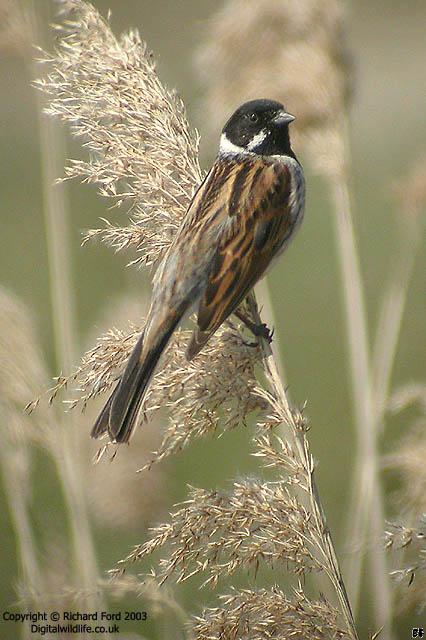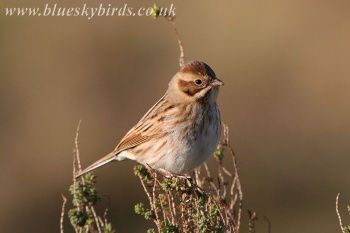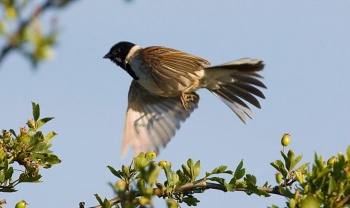(References updated) |
|||
| (15 intermediate revisions by 6 users not shown) | |||
| Line 1: | Line 1: | ||
| + | [[Image:Reed_Bunting.jpg|thumb|550px|right|Male<br />Photo by {{user|Richard+Ford|Richard Ford}}<br />]] | ||
| + | '''Alternative name: Common Reed Bunting''' | ||
;[[:Category:Emberiza|Emberiza]] schoeniclus | ;[[:Category:Emberiza|Emberiza]] schoeniclus | ||
| − | |||
| − | |||
| − | |||
| − | |||
==Identification== | ==Identification== | ||
| − | + | 14-16.5 cm (5½-6½ in)<br /> | |
| − | + | '''Breeding Male''' | |
| + | Black head and throat, white neck collar and underparts, heavily streaked brown back, deeply notched tail with white edges.<br /> | ||
| + | In '''winter''' the black is obscured by rufous-buff edging.<br /> | ||
| + | The '''female''' and '''immature''' are much duller, though still heavily streaked, lacking the black head and white collar. A buff [[Topography#Heads|supercilium]].<br /> | ||
| + | Legs reddish brown to black. Bill is dark and in most populations is small. | ||
| + | ====Similar species==== | ||
| + | [[Pallas's Bunting]] from eastern [[Siberia]] looks similar. However it's smaller, longer-tailed, the plumage is generally paler and it has a pale rump. | ||
==Distribution== | ==Distribution== | ||
| − | [[Europe]] | + | [[Europe]] and northern [[Asia]]. |
| − | |||
==Taxonomy== | ==Taxonomy== | ||
| + | [[Image:reedbunting_female.jpg|thumb|350px|right|Photo by {{user|postcardcv|postcardcv}}<br />Female]] | ||
| + | ====Subspecies==== | ||
| + | There are 15 subspecies<sup>[[#References|[1]]]</sup>: | ||
| + | *''E. s. schoeniclus'': [[British Isles]] and north-western [[Europe]] to central [[Russia]]; winters to North [[Africa]] | ||
| + | *''E. s. witherbyi'': Southern [[Portugal]], coastal western [[Spain]], [[France]], [[Balearic Islands]] and [[Sardinia]] | ||
| + | *''E. s. intermedia'': [[Italy]] and [[Sicily]] to southern [[Ukraine]], Crimea and north-eastern [[Turkey]] | ||
| + | *''E. s. reiseri'': [[Albania]], [[Macedonia]], and northern [[Greece]] | ||
| + | *''E. s. caspia'': Eastern Caucasus to western and southern [[Iran]], [[Syria]], adjacent south-eastern Turkey and north-eastern [[Iraq]] | ||
| + | *''E. s. korejewi'': Eastern Iran | ||
| + | *''E. s. pyrrhuloides'': Caspian Sea to Kazakhstan, western Xinjiang and western [[Mongolia]] | ||
| + | *''E. s. passerina'': North-western [[Siberia]]; winters to northern Xinjiang, Mongolia and northern Iran | ||
| + | *''E. s. parvirostris'': Central Siberia and northern Mongolia; winters to northern [[China]] | ||
| + | *''E. s. pyrrhulina'': Transbaikalia to Kamchatka, Kuril Island, Sakhalin, Hokkaido | ||
| + | *''E. s. pallidior'': South-western Siberia; winters Caucasus to north-western [[India]] and Mongolia | ||
| + | *''E. s. minor'': South-eastern Siberia and adjacent Manchuria | ||
| + | *''E. s. ukrainae'': Southern [[Russia]] to northern [[Ukraine]] and Volga River; winters to Caucasus | ||
| + | *''E. s. incognita'': Russia east of Volga to southern Urals, northern Kazakhstan; winters to north-western China | ||
| + | *''E. s. zaidamensis'': Western China (Tsaidam basin in northern Qinghai) | ||
==Habitat== | ==Habitat== | ||
| − | + | '''Breeds''' in almost any kind of marshy place: reedbeds, river banks etc but in '''winter''' will be found on farmland, particularly stubble fields. | |
| + | |||
==Behaviour== | ==Behaviour== | ||
| − | + | Forms mixed flocks in winter with other buntings and finches. | |
| − | + | ====Flight==== | |
| − | + | Erratic bursts of wing-beats. | |
| − | + | ====Diet==== | |
| − | == | + | Their diet consists mostly of seeds and other plant material with the addition of insects when feeding young. |
| + | ====Breeding==== | ||
| + | [[Image:Reed Bunting21.jpg|thumb|350px|right|Photo by {{user|targetman|targetman}}<br />[[Lincolnshire]] [[UK]] June 2008 ]] | ||
| + | They lay 4-7 eggs in a nest which is built in a bush or reeds | ||
| + | ====Vocalisation==== | ||
| + | '''Song''': repetitious "tseek, tseek, tseek, tissick". | ||
<flashmp3>Emberiza schoeniclus (song).mp3</flashmp3><br /> | <flashmp3>Emberiza schoeniclus (song).mp3</flashmp3><br /> | ||
''[[Media:Emberiza schoeniclus (song).mp3|Listen in an external program]]'' | ''[[Media:Emberiza schoeniclus (song).mp3|Listen in an external program]]'' | ||
| + | ==References== | ||
| + | #{{Ref-Clements6thAug17}}#Birdwatchers Pocket Guide ISBN 1-85732-804-3 | ||
| + | #Collins Pocket Guide to British Birds 1966 | ||
| + | #Collins Field Guide 5th Edition | ||
| + | #Wikipedia | ||
| + | {{ref}} | ||
==External Links== | ==External Links== | ||
{{GSearch|Emberiza+schoeniclus}} | {{GSearch|Emberiza+schoeniclus}} | ||
| − | [[Category:Birds]][[ | + | <br /> |
| + | {{Video|Reed_Bunting}} | ||
| + | [[Category:Birds]][[Category:Emberiza]][[Category:Bird Songs]][[Category:Videos]] | ||
Revision as of 00:23, 8 November 2017
Alternative name: Common Reed Bunting
- Emberiza schoeniclus
Identification
14-16.5 cm (5½-6½ in)
Breeding Male
Black head and throat, white neck collar and underparts, heavily streaked brown back, deeply notched tail with white edges.
In winter the black is obscured by rufous-buff edging.
The female and immature are much duller, though still heavily streaked, lacking the black head and white collar. A buff supercilium.
Legs reddish brown to black. Bill is dark and in most populations is small.
Similar species
Pallas's Bunting from eastern Siberia looks similar. However it's smaller, longer-tailed, the plumage is generally paler and it has a pale rump.
Distribution
Taxonomy
Subspecies
There are 15 subspecies[1]:
- E. s. schoeniclus: British Isles and north-western Europe to central Russia; winters to North Africa
- E. s. witherbyi: Southern Portugal, coastal western Spain, France, Balearic Islands and Sardinia
- E. s. intermedia: Italy and Sicily to southern Ukraine, Crimea and north-eastern Turkey
- E. s. reiseri: Albania, Macedonia, and northern Greece
- E. s. caspia: Eastern Caucasus to western and southern Iran, Syria, adjacent south-eastern Turkey and north-eastern Iraq
- E. s. korejewi: Eastern Iran
- E. s. pyrrhuloides: Caspian Sea to Kazakhstan, western Xinjiang and western Mongolia
- E. s. passerina: North-western Siberia; winters to northern Xinjiang, Mongolia and northern Iran
- E. s. parvirostris: Central Siberia and northern Mongolia; winters to northern China
- E. s. pyrrhulina: Transbaikalia to Kamchatka, Kuril Island, Sakhalin, Hokkaido
- E. s. pallidior: South-western Siberia; winters Caucasus to north-western India and Mongolia
- E. s. minor: South-eastern Siberia and adjacent Manchuria
- E. s. ukrainae: Southern Russia to northern Ukraine and Volga River; winters to Caucasus
- E. s. incognita: Russia east of Volga to southern Urals, northern Kazakhstan; winters to north-western China
- E. s. zaidamensis: Western China (Tsaidam basin in northern Qinghai)
Habitat
Breeds in almost any kind of marshy place: reedbeds, river banks etc but in winter will be found on farmland, particularly stubble fields.
Behaviour
Forms mixed flocks in winter with other buntings and finches.
Flight
Erratic bursts of wing-beats.
Diet
Their diet consists mostly of seeds and other plant material with the addition of insects when feeding young.
Breeding
They lay 4-7 eggs in a nest which is built in a bush or reeds
Vocalisation
Song: repetitious "tseek, tseek, tseek, tissick".
<flashmp3>Emberiza schoeniclus (song).mp3</flashmp3>
Listen in an external program
References
- Clements, J. F., T. S. Schulenberg, M. J. Iliff, D. Roberson, T. A. Fredericks, B. L. Sullivan, and C. L. Wood. 2017. The eBird/Clements checklist of birds of the world: v2017, with updates to August 2017. Downloaded from http://www.birds.cornell.edu/clementschecklist/download/
- Birdwatchers Pocket Guide ISBN 1-85732-804-3
- Collins Pocket Guide to British Birds 1966
- Collins Field Guide 5th Edition
- Wikipedia
Recommended Citation
- BirdForum Opus contributors. (2024) Reed Bunting. In: BirdForum, the forum for wild birds and birding. Retrieved 19 April 2024 from https://www.birdforum.net/opus/Reed_Bunting
External Links






